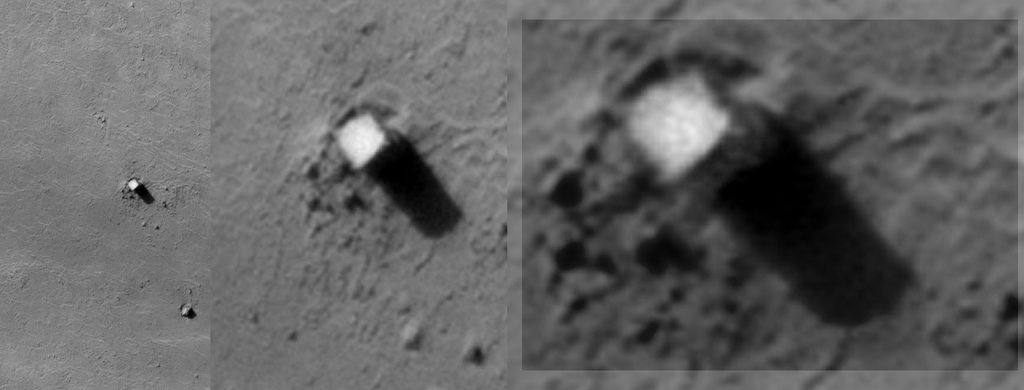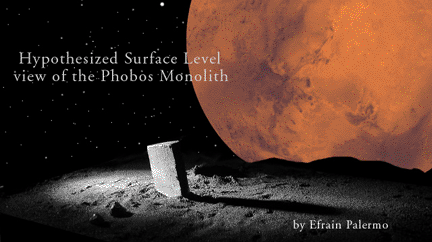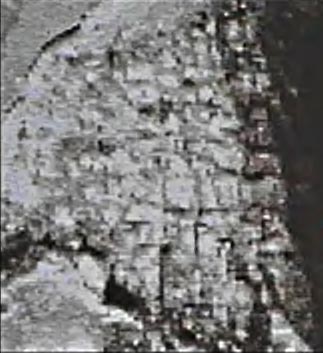
Posted on 12/24/2013 9:13:13 PM PST by SunkenCiv
Explanation: What does the Martian moon Phobos look like? To better visualize this unusual object, images from ESA's Mars Express orbiter have been combined into a virtual rotation movie. The rotation is actually a digital illusion -- tidally-locked Phobos always keeps the same face toward its home planet, as does Earth's moon. The above video highlights Phobos' chunky shape and an unusually dark surface covered with craters and grooves. What lies beneath the surface is a topic of research since the moon is not dense enough to be filled with solid rock. Phobos is losing about of centimeter of altitude a year and is expected to break up and crash onto Mars within the next 50 million years. To better understand this unusual world, Mars Express is on course to make the closest flyby ever on Sunday.
(Excerpt) Read more at 129.164.179.22 ...

The Phobos monolith is a large rock on the surface of the moon Phobos,[1] which orbits Mars. It is a boulder about 85 m (279 ft) across.[2] A monolith is a geological feature consisting of a single massive piece of rock. Monoliths also occur naturally on Earth, but it has been suggested that the Phobos monolith may be a piece of impact ejecta. The monolith is a bright object near Stickney crater, described as a "building sized" boulder, which casts a prominent shadow.[3][4] It was discovered by Efrain Palermo, who did large surveys of Martian probe imagery, and later confirmed by Lan Fleming, an imaging sub-contractor at NASA Johnson Space Center.
The general vicinity of the monolith is a proposed landing site for a Canadian Space Agency vehicle, funded by Optech and the Mars Institute, for an unmanned mission to Phobos known as PRIME (Phobos Reconnaissance and International Mars Exploration).[3] The PRIME mission would be composed of an orbiter and lander, and each would carry four instruments designed to study various aspects of Phobos' geology.[5] At present, PRIME has not been funded and does not have a projected launch date.
Some great photos and interesting info at that site you linked to.
Porosity would suggest a formation (perhaps from a larger former body) with high heat, resulting in expansion of various materials such as water into vapor, leaving voids as the vapor eventually escaped. On Earth we see pumice, which would be analogous, but which has the gases still in the voids. One of the problems with excavating Herculanaeum is that the stone has billions of pores still containing the poisonous gases belched up by the 79 AD eruption.


Mars has craters, but the distribution of those craters shows that many of them on one side of the planet were formed in a single impact event — either a grapeshot-style with a single bolide breaking up from Mars’ gravity and smashing in many places more or less simultaneously, or more likely, one large impact which threw up ejecta. Could have been an earlier moon of Mars that did it, but Mars has more potential exposure to large asteroids than we do. The two moons probably arrived at the same time, as the odds of capture are much better when three bodies are involved, rather than two.
My pleasure.
"The original HiRISE satellite image supplied to Mail Online by the University of Arizona showing a close up of what appears to be a 'monolith' on Mars..."
"speaking about the satellite picture scientist Alfred McEwen, the principal investigator from the University of Arizona's HiRISE department, said: 'There are lots of rectangular boulders on Earth and Mars and other planets.
'Layering from rock deposition combined with tectonic fractures creates right-angle planes of weakness such that rectangular blocks tend to weather out and separate from the bedrock.'
Fuel was added to the flames after Buzz Aldrin, the second man to walk on the Moon, alluded to a similar monolith detected on Mars' moon Phobos.
Speaking on a U.S. cable television channel last week he said: 'We should visit the moons of Mars.
'There's a monolith there - a very unusual structure on this little potato shaped object that goes around Mars once every seven hours."
http://www.dailymail.co.uk/sciencetech/article-1204254/Has-mystery-Mars-Monolith-solved.html

Adapted from U.S. Geological Survey photo by S. R. Brantley.
Large eruptions of basalt lava may create deep flows of molten rock. As the rock slowly cools it shrinks slightly. The stresses cause jointing in several different planes, and columns of rock form with a generally hexagonal shape, like pencils. The flow shown here is at Sheepeaters Cliff, in Yellowstone National Park. Note that there is a strongly developed horizontal jointing here, too.
The piece of basalt below displays the six-sided cross section of a column. Some columns may have five or seven sides instead.

http://geology.about.com/library/bl/images/blbasaltcolumns.htm

Adapted from U.S. Geological Survey photo by S. R. Brantley.
Large eruptions of basalt lava may create deep flows of molten rock. As the rock slowly cools it shrinks slightly. The stresses cause jointing in several different planes, and columns of rock form with a generally hexagonal shape, like pencils. The flow shown here is at Sheepeaters Cliff, in Yellowstone National Park. Note that there is a strongly developed horizontal jointing here, too.
The piece of basalt below displays the six-sided cross section of a column. Some columns may have five or seven sides instead.

http://geology.about.com/library/bl/images/blbasaltcolumns.htm
Everything after “But 4 flat sides is very odd in nature.” was from the website I linked to.
Sorry about the dupe. My finger slipped. :)
Let’s send a lander there to see it up close!
Apparently some are at right angles to each other. That could possibly explain the 4-sided structure of the monolith as impact-ejected rock.

“That could possibly explain the 4-sided structure of the monolith as impact-ejected rock.”-me
But then of course, how could it be that the ‘impact-ejected rock’ came to land perfectly right side up? Unless it perhaps rose straight up from below the surface as a result of an impact.
Sorry, I can't at this time. Christmas has tapped me out. Maybe sometime afterwards. :)

(c) 2001 Andrew Alden, licensed to About.com, Inc.
Rocks are brittle, so they crack, but they crack very carefully. When this body of gneiss was deep underground during the folding and uplift of the southern Sierra Nevada, the stresses made it fracture. The cracks are called joints. You can see that they come in three different sets. The first set is parallel to the surface of this rock exposure, so that it looks like layers. The second set runs up the photo and the third runs diagonally from upper left to lower right. The stream in the picture has plucked out the resulting joint blocks to form its rugged streambed.
Joints are like faults, except that there is no movement along them. Joint patterns can be mapped to yield insights into the stresses that have affected the region during its geologic history. Sometimes jointing can occur as a body of rock is uncovered by erosion. As the overlying weight is removed, internal stresses may create jointing that results in the erosional process of exfoliation. That is common elsewhere in the Sierra, and perhaps it's an element at this locality too.





Sugar plums - everyone knows that...
Those pics you just posted very well support the idea that the 4-sided feature (”monolith”) is natural, as at least some of the linear features on Phobos (joints, bedding, whatever) ARE at right angles to each other.
Disclaimer: Opinions posted on Free Republic are those of the individual posters and do not necessarily represent the opinion of Free Republic or its management. All materials posted herein are protected by copyright law and the exemption for fair use of copyrighted works.